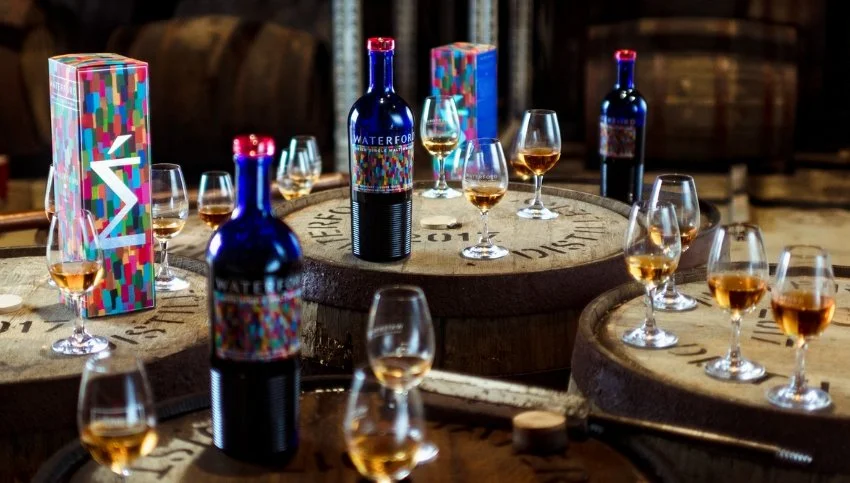The people-centred philosophies behind astonishing Irish whiskeys
Like many things in life, we often make whisky much more complicated than it needs to be. But over in Ireland, Waterford and Roe & Co are layering up flavour in surprising ways – with people at the heart of the process.
Over the 12-and-a-bit years I’ve been writing about whisky, it’s become increasingly apparent that the magic of that hard-to-define distillery character doesn’t fully lie in production. Or indeed raw materials. Instead, it stems from something we definitely don’t talk about enough. It’s the philosophy of the makers that defines the soul of a whisky.
I recently worked on my first piece for Drinks Retailing – a paddle (there’s rarely enough space on-page for a deep dive!) into the proliferation of cask types in Irish whiskey expressions. Press releases had crossed my desk with three, four, five different wood influences in a single expression. Surely we’re at saturation point, I thought. If you’re shoe-horning that much flavour into a bottle, surely you’re hiding something?! It felt a bit like a lesson in the adage ‘just because you can do it, doesn’t mean you should’.
It was a fascinating piece of research. Primarily because, from two makers in particular, I was struck by how the ideas behind an expression really run deep. It sounds obvious – but in a world where we often talk about casks (as I was!) or fermentation, or any other aspect in the distillery, we rarely shine a light on why the person behind the process has made those decisions. Because ultimately flavour has to be imagined first.
‘Instinctive whiskey-making’
First up: Roe & Co. The Dublin distillery made whiskey headlines in February when its inaugural release hit the shelves. Five years in the making – the distillery started its build in 2019 – it offers a fascinating take on maturation. Instead of undertaking a finishing process, the expression has been matured in a solera-type system, with each criadera a different cask type. There are five in total: refill and first fill American oak ex-bourbon, new alligator-charred American oak, and chestnut barrels with two different toasting profiles.
For head distiller Lora Hemy, it’s a nod to a people-first way of making whiskey. “It's a process where we've tried to take a different approach to whiskey creation,” she told me. “It's centred people and process and the instinctive parts of whiskey-making over a more traditional method. That might involve sampling casks and tasting in increments over time and then putting something together as a recipe in a lab. This has been more of a live whiskey creation process.”
While I’ve yet to taste the expression (I am sweating to..!), it’s clearly a way of crafting a complex whiskey with inherently well-integrated flavours. It also feels a bit more democratic. “With a Solera, it was a way for everybody that's ever worked at the distillery and as part of our liquid [team] to have a hand in every single bottle,” Hemy continued.
“The nature of a Solera system means that you're leaving within the Solera elements from the first casks to be filled into it. That's the whole purpose of the Solera system, not just because it involves everybody, but because it can tell a story over time in terms of liquid.”
It’s a compelling proposition – a whiskey that literally wouldn’t exist in its form without every single person having the influence they did. There’s a romance to this – and I hope the distillery continues to shout about it going forward. I can’t be the only one this angle resonates with.
Complexity through cuvée
Two hours south by car lies Waterford Distillery. The whiskey-maker is known for its terroir-driven philosophies and biodynamic approaches. Founded in 2015 by ex-Bruichladdich owner Mark Reynier, Waterford is synonymous with disruptive approaches. Informed in large part by winemaking, there’s a constant focus on the people right at the very start – the farmers that grow the barley that ultimately underpin it all.
Its latest release, Waterford Cuvée Koffi, is billed as the most complex from the distillery to date. Not only is it made from 24 different single farm origins, it takes in four different casks too. But the first-fill and new American oak, French oak and Vin Doux Naturels casks aren’t meant to mask anything. The philosophy here is to use the casks to if anything accentuate the natural spectrum of flavour that comes from the barley.
“The whole raison d’etre of Waterford Whisky is to unearth whisky’s most natural flavour,” head distiller Ned Gahan explained to me. “Oak integration is a part of this of course, but really impossible to talk about without the context of everything that comes before.” Hence the importance of both the farmer, and the philosophy of Reynier and the team. Everything hinges on both. “When we’re putting whiskies together, our first thoughts are about the character of the farm, the barley, and utilising the different casks to fully express them, much as a winemaker would.”
I have tasted Koffi – and it is indeed as intricately complex as you’d hope after all this flavour layering. It’s rich, bready and soft on the nose, despite its 50% ABV. Toffee apples, honey and a beautiful floral note come through on the palate, plus a more savoury tea-like element. It’s tricky to briefly sum up as there’s so much going on. Indeed, its profile has been visualised by artist Nathanaël Koffi in the label art – vibrant blocks of colour weave their way like a tapestry across the label. It feels bright, happy, optimistic. But if you want to, you could get lost in the mesmerising pattern for hours.
Two very different whiskeys made their own impact on me this month, both for their people-centred approaches. An interesting reminder – let’s never stop celebrating the minds and the makers behind the process.


